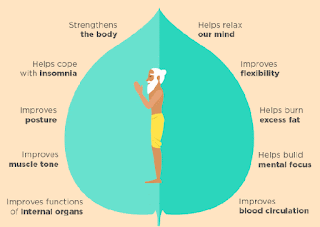Pranayama - Ancient breathing techniques in Yoga
Pranayama - Ancient breathing techniques in Yoga
 |
| Yogi Kamal Ji doing Pranayama & Meditation at Mouni Baba Cave on the way to Neelkanth (Lord Shiva) Temple |
- Proper diet: The Hatha yoga texts place major emphasis on 'mitahara', which connotes "measured diet" or "moderate eating".
Several Hatha Yoga texts like 'Hatha Yoga Pradipika', 'Gheranda Samhita' and 'Shiva Samhita' includes 'mitahara' as an essential part of a Hatha yoga holistic practice.
According to Hatha Yoga Pradipika, verse 1.57,
"A Brahmachari, practicing 'mitahara' (moderate diet) and 'tyaga' (renunciation, solitude), devoted to yoga achieves success in his inquiry and effort within half a year."
Verses 1.57 through 1.63 of the critical edition of Hatha Yoga Pradipika suggests that taste cravings should not drive one's eating habits, rather the best diet is one that is tasty, nutritious and likable as well as sufficient to meet the needs of one's body and for one's inner self. It recommends that one must "eat only when one feels hungry" and "neither overeat nor eat to completely fill one's stomach; rather leave a quarter portion empty and fill three quarters with quality food and fresh water". - Proper body cleansing: Hatha yoga teaches various steps of inner body cleansing with consultations of one's yoga teacher. The most common list is called the 'shatkarmas', or six cleansing actions: 'Dhauti' (cleanse teeth and body), 'Basti' (cleanse bladder), 'Neti' (cleanse nasal passages), 'Trataka' (cleanse eyes), 'Nauli' (abdominal massage) and 'Kapalabhati' (cleanse phlegm).
The actual procedure for cleansing varies by the Hatha yoga text, with some suggesting water wash and others describing the use of cleansing aids such as cloth. - Proper posture: Once a peaceful stable location has been set, the yogi begins the posture exercises called asanas. These Hatha yoga postures come in numerous forms.
- Pranayama (Proper breathing): 'Pranayama' is made out of two Sanskrit words 'prana' (प्राण, breath, vital energy, life force) and 'ayama' (आयाम, restraining, extending, stretching).
Some Hatha yoga texts teach breath exercises but do not refer to it as Pranayama. For example, Gheranda Samhita in section 3.55 calls it 'Ghatavastha' (state of being the pot).
In others, the term 'Kumbhaka' or 'Pranasamrodha' replaces 'Pranayama'. Regardless of the nomenclature, proper breathing and the use of breathing techniques during a posture is a mainstay of Hatha yoga. Its texts state that proper breathing exercises cleanse and balance the body.
'Pranayama', is a concept shared with all schools of yoga.
This is done in several ways, inhaling and then suspending exhalation for a period, exhaling and then suspending inhalation for a period, slowing the inhalation and exhalation, consciously changing the time/length of breath (deep, short breathing), combining these with certain focussed muscle exercises. 'Pranayama' or proper breathing is an integral part of asanas. According to section 1.38 of Hatha Yoga Pradipika, 'Siddhasana' is the most suitable and easiest posture to learn breathing exercises.
The different Hatha yoga texts discuss pranayama in various ways. For example, Hatha Yoga Pradipka in section 2.71 explains it as a threefold practice: 'recaka' (exhalation), 'puraka' (inhalation) and 'kumbhaka' (retention). During the exhalation and inhalation, the text states that three things move: air, 'prana' and yogi's thoughts, and all three are intimately connected.
It is 'kumbhaka' (retention of breath) where stillness and dissolution emerges. The text divides 'kumbhaka' into two kinds: 'sahita' (supported) and 'kevala' (complete). Sahita kumbhaka is further sub-divided into two types: retention with inhalation, retention with exhalation.
Each of these breath units is then combined in different permutations, time lengths, posture and targeted muscle exercises in the belief
that these aerate and assist blood flow to targeted regions of the body.
Meditation is the ultimate goal of all the preparatory cleansing, asanas, 'pranayama' and other steps. After one has successfully mastered these steps, one can effectively meditate and achieve the 'ultimate goal'.
Content souce: https://sagesyoga.com/blog/pranayama-ancient-breathing-techniques-in-yoga.php


Comments
Post a Comment